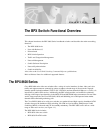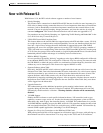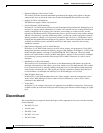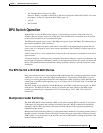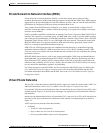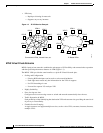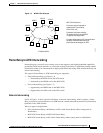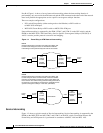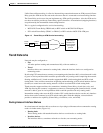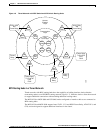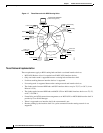
1-9
Cisco BPX 8600 Series Installation and Configuration
Release 9.3.10, Part Number 78-11603-01 Rev. D0, July 2001
Chapter 1 The BPX Switch: Functional Overview
BPX Switch Operation
Private Network to Network Interface (PNNI)
Private Network to Network Interface (PNNI) is a link-state routing protocol that provides
standards-based dynamic ATM routing with QoS support as defined by the ATM Forum. PNNI supports
aggregation for private ATM addresses and links between switches, and can scale the network and its
performance by configuring PNNI peer groups and hierarchical levels.
A key feature of the PNNI hierarchy mechanism is its ability to automatically configure itself in
networks in which the address structure reflects the topology. It is responsive to changes in network
resources and availability.
PNNI is available on the BPX switch when an optional Cisco Service Expansion Shelf (SES) PNNI is
installed. This controller is connected locally to a BPX 8600 series switch to provide PNNI signaling
and routing for the establishment of ATM and Frame Relay switched virtual circuits (SVCs) and Soft
Permanent Virtual Circuits (SPVCs) over a BPX 8600 wide area network. The network created with
BPX SES PNNI nodes also supports traditional ATM and Frame Relay permanent virtual circuits
(PVCs) in a separately partitioned AutoRoute network.
ATM SVCs are ATM connections that are established and maintained by a standardized signaling
mechanism between ATM CPE (ATM end systems) across a Cisco WAN switching network. ATM
SVCs are set up in accordance with user demand and removed when calls are completed, thus freeing
up network resources.
BPX SES PNNI node resources, such as port virtual path identifier (VPI) range and bandwidth and
trunk bandwidth, are partitioned between SVCs/SVPCs and PVCs. Resource partitioning provides a
firewall between PVCs and SVCs/SVPs so that problems with CPE or large bursts do not affect the
robustness and availability of PVC services. Bursty data for either PVCs or SVCs/SPVCs can always
use any unused link bandwidth, regardless of partitioning.
For a brief description of the SES PNNI, see Service Expansion Shelf PNNI, page 2-8. Refer to the
Cisco SES PNNI Controller Software Configuration Guide for detailed information abut the SES.
For further information about PNNI and the SES, refer to the Cisco SES PNNI Controller Software
Configuration Guide.
Virtual Private Networks
This section is a brief description of the BPX switch’s support for Virtual Private Networks (VPN). For
additional information, refer to the Cisco MPLS Controller Software Configuration Guide.
Conventional VPNs that use dedicated lease lines or Frame Relay Private Virtual Circuits (PVC) and a
meshed network (Figure 1-2) provide many advantages, but typically have been limited in efficiency
and flexibility.
Instead of using dedicated leased lines or Frame Relay PVCs, and so on, for a VPN, an IP virtual private
network uses the open connectionless architecture of the Internet for transporting data as shown in
Figure 1-2.
An IP virtual private network offers these benefits:
• Scalability
–
Avoids VC mesh configuration
–
Easy to add a new site since IP is connectionless
–
Service provider handles router service management



